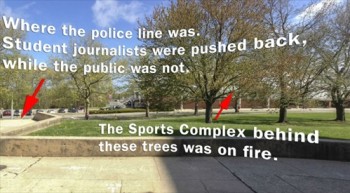
(Image created by Wasim Ahmad.)
There are journalists, and then there are police.
And then there are student journalists. And campus police.
Whereas battle-hardened, experienced journalists know how to pick their battles and navigate their way around how the police sometimes operate (which in some cases, is in clear violation of established law), that’s not always the case with student journalists.
While the campus police at colleges and universities are often, if not always, full-fledged police officers (as they are where I am an Assistant Professor, Stony Brook University) with the same training and background as police officers in their respective counties, students don’t and can’t have that same advantage – they’re still developing their skills and as people.
Inevitably, the journalist-police conflict arises, and when it does, students susceptible to suggestion and sometimes fearful of authority often bow down to it – as has happened at Stony Brook University in several incidents in the last few months.
What happened?
Stony Brook University’s sports complex caught fire on Feb. 6, and a large group of student media gathered to cover the incident. They pointed their SLR cameras from behind the police lines at the building, hundreds of yards away from the building and the fire. The smoke was pouring out from the far end of the structure that the students couldn’t even see from their vantage point.
.JPG)
See above a map of Stony Brook University’s campus (from the university’s website). I added arrows, labels and the fire to show where media was moved.
Which made it all the more puzzling, when police officer Danielle Snyder followed orders over her radio that told her to push the student media back even further away from the police lines and toward another part of campus. I was in the group that she asked to move back and initially we complied. That is, until I saw another couple of students walk up to the police line where we had just been pushed back from.
I stopped and asked Officer Snyder why we were being moved back while two other students who had just arrived at the yellow tape weren’t asked to do the same – I explained that the media had the right to be where the public was. She told me that media had to move back, at which point I told her again that I was a journalism professor and not the media. She said that we had cameras, so we had to be moved back to the Simons Center, about 120 yards away from the police line. (Check out a 3D panorama showing the distance students were asked to move)
I didn’t move, and so, after asking me again to move back several times, she radioed her supervisor, Lieutenant Richard Nolan, to help her. He didn’t.
A panoramic shot of the area of the sports complex fire – click to enlarge and see where the fire was and where students were asked to move. Click and drag to look left and right through the image.
Instead, he arrived and reversed Snyder’s call and informed the student media and myself that, indeed, we were allowed right up to the police lines – exactly where the public could be as well.
I asked the University Police to speak to Nolan or Snyder about what, exactly, happened that day. While they weren’t allowed to speak to me, their supervisor, Assistant Chief Eric Olsen, did.
“It was really just a mistake, it was confusion. Officer Snyder radioed that there was press on the scene” he said in an interview with iMediaEthics. “[The chief on the scene] thought it was outside media looking for a briefing, so he wanted them in a briefing spot … Officer Snyder was following orders.”
That misinterpretation was cleared up by Nolan on the scene.
“Lieutenant Nolan came, he clarified things, he realized it wasn’t people looking for a briefing, it was the general media and he let you right through,” Olsen said.
But shouldn’t an officer know what the laws are regarding where the public (and therefore, the media) can stand and photograph from?
“I agree,” Olsen said. “It all requires training.”
Olsen said that many times, officers don’t encounter a situation every day, and don’t necessarily know what to do – and that’s why the department issued a memo on April 15 that instructs officers to always call a supervisor if an issue comes up with student journalists on campus. Olsen would not provide the e-mail to iMediaEthics.
So what about this memo?
What spurred this memo was another incident with Officer Snyder.
On Sunday, April 14, two students from Stony Brook University’s School of Journalism were filming for a piece about brain mapping advancements for their weekly news show – a story that necessitated a stand-up filmed in front of Stony Brook University Hospital.
After filming a few shots of the hospital’s signage, they were walking with their camera equipment in a lawn area in front of the hospital when Snyder pulled up to them, demanding their IDs (something which was recently ruled that even the MTA police can’t do).
The officer cited several reasons, according to one of the students, Michelle Frantino, a former student of mine.
“She then told us we were suspicious persons. She said she had numerous complaints from people that we were filming. She told us this is a hospital where sick people come and they don’t appreciate people like ‘us’ filming them,” Frantino wrote in a statement to her professor about the incident, one that she also provided to iMediaEthics.
She said that Snyder took their IDs, and kept them waiting for about 10 minutes before returning from her car. She then told the students to leave state property, saying that they weren’t allowed to film there without a signed hard-copy letter from the university’s Media Relations Department. Frantino wrote that Snyder told them she was letting them go (as in leave the grounds of the hospital, not continue filming) because they were Stony Brook University students, but had they been anyone else, they would have been arrested.
Frantino described the officer’s attitude as less-than-courteous, an assessment I can believe from my own encounter with her at the fire. While something like that won’t stop me from filming – it does have an effect on someone who is still in college learning how to be a journalist.
“It was really disappointing to be treated that way as a student and I have to be honest, it has left my 371 class [Advanced broadcast] fearful to shoot anywhere other than the academic mall,” Frantino wrote.
What’s changed?
Olsen didn’t make any excuses for Officer Snyder’s actions.
“That didn’t necessarily have to happen,” Olsen said. “They didn’t have to leave.”
He said that he talked to Snyder about how the encounter was handled.
“We corrected her. We don’t want a blanket thing like ‘You didn’t notify us, you have to leave,’” Olsen said. “We want to be good neighbors with our students here, and the press in general.”
Olsen said that, according to call logs, an EMS driver said that the students were blocking the ambulance lanes to the hospital, a claim that the students deny. While their shots don’t appear to be from any street, Olsen said that even if it was, that the offending party could simply be moved off the street and allowed to continue filming.
“We should facilitate any member of the press or a journalism student, as far as giving them direction, we certainly can identify them,” Olsen said. “ But we shouldn’t unilaterally tell them to leave an area simply because they were filming.”
He offered one possible explanation for why Snyder incorrectly asked the students to leave:
“It’s something I think the officer doesn’t necessarily deal with that often, so I think it was a new thing for the officer,” Olsen.
Though considering the same officer was involved in the sports complex fire incident, it certainly wasn’t the first time.
Regardless, Olsen said that the same memo that tells officers to call a supervisor lets them know that the public and journalists have a right to film on campus. Olsen said this memo was a reiteration of those rights.
“As much as we train, officers are going to make honest mistakes. Some officers maybe won’t pay attention when we’re training them – we try to keep that percentage as small as possible, and we think it is, but it still happens.” Olsen said. “We’re people. This is our job. Every officer has a different level of competency, different areas they are good in, strengths and weaknesses.”
As far as Snyder’s attitude? Olsen said that the students are always welcome to file a civilian complaint.
The Dean of the Stony Brook University School of Journalism, Howard Schneider, hoped for a positive outcome from the memo.
“The recent incident with two of our students served as a catalyst for us to make progress with the police in ending any ambiguity of confusion as to the basic rights of student journalists,” Schneider wrote in an e-mail to iMediaEthics. “After a meeting with police officials, the police chief reaffirmed to his staff the First Amendment rights of students to take photos and interview subjects on public property.”
I tested whether this memo made a difference – on April 20, less than a week after Officer Snyder told the two students to stop filming and leave campus, I went out to the hospital, wearing a Stony Brook hooded sweatshirt and cargo pants. Even though between that incident and my test, the Boston Marathon bombings had everyone on edge, I was able to film for one hour uninterrupted from various positions in front of the hospital, including the area where the two students had been standing.

I tried my best to look like a student and film the hospital on April 20. Nobody stopped me and two different officers drove by three times without incident. The same happened at the main entrance of the university.
I also went out to the front of the university’s main entrance and pointed my camera for a half-hour at several buildings on campus.
In both instances, several police officers drove by me, but none stopped or gave me a hard time.
Other students reporting on campus, and Frantino herself, have reported the same since the memo.
What’s the solution?
Any interaction involves at least two sides – and the baggage that people bring to that interaction can set the tone for all that follows.
“Your interaction with the police, oftentimes, it begins with how the officer treats the individual when he initially approaches and it also goes the other way back – and this goes with the press or the public – how that individual reacts to the officer,” Olsen said. “Every police officer doesn’t have the same personality just like every member of the public or the press doesn’t have the same personality. And at times when that interaction comes, it’s one side or the other that dictates how the rest of the conversation goes.”
That said, on a college campus, a personality should be more of a prerequisite when dealing with inexperienced student journalists, many of whom may be experiencing police questioning for the first time. What would help officers in these situations, Olsen said, would be for students to wear their press badges – issued by the School of Journalism, but seldom worn by the students. It’s something commonly seen with reporters outside the campus.

A typical School of Journalism Press Pass – many student media outlets have the same.
Another suggestion from Olsen was to call ahead when filming. While that’s sometimes possible – say, a feature story or something along those lines – there are times when calling ahead isn’t always a journalistic best practice or even practical. At Stony Brook University, which has a news broadcast published three times per week on the web, School of Journalism students can’t always be expected to make a phone call just to film, nor would the police likely want that many students calling. It’s not something that’s expected of journalists out in the field, either.
I’ve often found other ways – there are times where it’s worth standing your ground, and there are times where it’s easier to just find another shot from another angle or place – in the time spent arguing First Amendment rights, it’s easy to miss the story unfolding.
How the incidents at Stony Brook can teach universities with J-Schools
One of the outcomes of Schneider’s meeting with the police was that Stony Brook University will pilot a training model where the University Police and the School of Journalism will collaborate on workshops intended to train police and journalists about interacting with each other.
These workshops are set to begin in the fall semester.
“The police will present a workshop for our students and faculty on how they conduct investigations on campus and what information they routinely are required to release to the public.” Schneider wrote. “We, in turn, will conduct a workshop on how journalists cover stories on campus and our understanding of what information we expect to be released and when.”
The workshops will be videotaped – and the videos will be shown to officers who couldn’t make the training, new recruits, new students, and possibly even other police departments and journalism schools across the country.
“It’s the beginning of what I think will be a very productive dialogue. Will it totally solve all press-police problems going forward? Probably not.” Schneider wrote. “But I’m very optimistic it will minimize tensions.”
A note about the reporting
Students often tell me that they get the runaround when dealing with campus officials. And so did I.
I e-mailed Olsen and Nolan on April 9. Nolan originally agreed to meet with me. On April 11, I received an e-mail from Olsen asking me to speak to Media Relations instead, and they were copied in on that e-mail. So I asked, via that same e-mail, to speak to Olsen through Media Relations. I received a response from Barbara Chernow, the Senior Vice President of Administration, that then cleared Olsen to speak to me about any further questions.
Media relations has made it a practice to say that they don’t require that all departments go through them for comment at Stony Brook University. But it doesn’t seem that way when all roads lead to them – for clearance for a faculty member to talk to a colleague on campus.
While, after a slight delay, I was able to talk to Olsen, it’s the kind of bottleneck that might scare off a young journalist – when they get an e-mail from the Senior Vice President of Administration. In this case, the e-mail was to my benefit, but that may not always be the case.







Comments Terms and Conditions